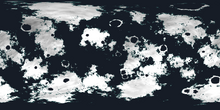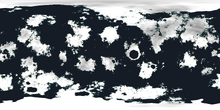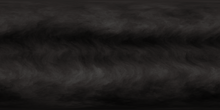
K'Jiritsz and moon K'Larsz
K'Jiritsz is one of the most alien worlds the Isvoy has come across in its mission. It is located in the Small Magellanic Cloud, the last planet in a system featuring an extremely dim L9-Class brown dwarf star. It is the last planet in the system, orbiting at a distance of 0.637AU from the star every 2.83 years. It has a rotational period of 4.8 days Owing to it's similar size, atmospheric makeup of almost 90% methane, and presence of an advanced civilization on its surface. That description is apt, since it has a deep red hue from its star. Conditions on the surface however contribute to the moniker, at an estimated ESI of just 0.34 . Average temperature is an extremely inhospitible (to humans) -170 Centigrade.
K'Larsz (8.1) is the only moon of K'Jiritsz, it has an atmospheric pressure suitable for colonization. The moon is colonized by the native K'Jirita, and they use it as a kind of vacation destination. The gravity of

K'Jiritsz terrain, with mountains. Note the thick methane clouds. This is as bright as daytime gets on K'Jiritsz.
the moon is slightly lower, at 0.32g, allowing a recreational activity known as "Cloudhopping".
Life on K'Jiritsz[]
The native K'Jirita are a methane-based species. They are a warp-capable species that had developed the technology thousands of local years ago. They are an early Type-II civilization that harnesses the power of their dim star for their own use. Although the power output is very dismal as far as stars go, the K'Jirita are an extremely resourceful people, and their star provides them with far more than enough energy to meet their needs.

Radar survey to see what exists beneath the clouds. Methane snow fields abound.
They look far different than the humans aboard the Isvoy are used to. Their cities look ornate as well. Due to the dim light coming from the star, and the constant methane clouds, their cities are pitch black at night since they can see in the dark.
Despite the harshness to humans, most K'Jirita think the planet is an ideal place to live. One of the most popular spots is a forest located in the northern hemisphere. The forest is dominated by T'laszu trees which have one "trunk" which soars skyward and spirals around a central point. They have no leaves, instead deriving nutrients from the thick clouds of methane that often cover the forest.
The cloud cover made visual scans of the surface useless, so radar scans were used instead. They revealed vast methane snowfields, a few bare spots where K'Jirita cities were located, and methane seas. The methane based animals studied were quite strange-looking as well. One analogue of a "fish" had 6 eyes, 2 tails, and apparently swam "backwards". A "Bird" analogue had massive wings to soar in its thick atmosphere, but no feathers, and 4 talons.
The "Vacation Moon"[]

Radar map of K'Larsz
K'Larsz is known by the K'Jirita as the "Vacation Moon" as translated from their complex language. Radar scans showed a near-identical makeup to Kjiritsz, suggesting a massive impact early in the planets formation, the leftovers forming the moon. How it got the same exact atmosphere though is anyone's guess. The leading theory suggests that it was terraformed, however the K'Jirita society, according to translated news broadcasts, did not invent terraforming. In response, the Isvoy left a covert probe in orbit to collect data.
The Star[]

Radar scan of the star
The central star of the system is an L9-Class brown dwarf, which afforded a unique opportunity to the captain of the Isvoy to dive into the atmosphere. While this may have seemed like a foolhardy move, the Isvoy is rated to stand temperatures up to L7-Class. So, the captain saw this as an opportunity to study the star up close, and to take on plasma fuel.
As the Isvoy approached the star, they discovered a Dyson sphere in an extremely close orbit to the star, which the K'Jirita use to collect energy. It saw no K'Jirita ships in the area on visual scans, and other spectrums resolved nothing either, until they saw black blob-like shapes. Apparently, their ships were made in line with their civilization - they reflect no light at all.

The burning inferno of an L9-Class's atmosphere.
Diving into the stars atmosphere, a plasma refueling hose was extended, as the Isvoy ran scans of the surface below. The scans returned what seemed like automated mining facilities, mining fuel for the K'Jirita ships, although scans did not detect any exhaust coming from them. Surely they must be using some form of exotic propulsion method undetectable to the Isvoy's sensors.
The isvoy refueled, it departed the stars atmosphere, and then departed the system, a month after it arrived. A log will be sent to nearby stations, and top brass will determine if the K'Jirita people meet the criteria for inclusion in the greater galactic civilization.
